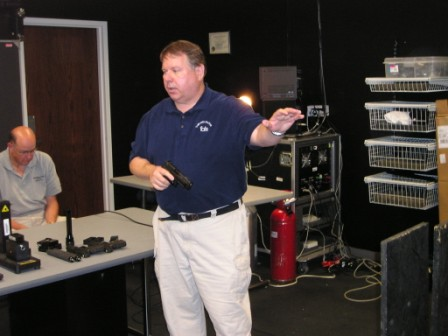Jerry Cooper: Use Of Force Tips For WPA Attendees – Part II
Part II. Officer Safety (Tactical) Considerations
By Jerry P. Cooper, Use-of-Force Trainer / Consultant
Note: In Part I, we took a look at some of the more important legal issues involving use-of-force by law enforcement officers. In this installment, we consider just a few tactical considerations from an officer safety perspective. Applying these lessons will hopefully result in a rewarding experience for those participating in the firearms simulation training at the Writers’ Police Academy.
Time. Here is an important survival formula:
TIME = COVER + DISTANCE + MOVEMENT
If we can stretch out the time line in a critical incident, then it is usually to our benefit to do so. Gaining more time allows for backup to arrive, and allows you an opportunity to get your heart rate down.
You can safely give verbal directions, and are usually not forced to use certain options if you take cover. Cover is anything that will stop a bullet. An officer should always be looking for cover.
Creating distance buys you valuable seconds to choose the most appropriate force option. It also makes you a smaller target, and may bring you closer to cover.
In most critical incidents, the officer usually suffers the disadvantage of having to react to the suspect. By moving, especially laterally, the officer becomes the action, and now, the suspect is forced to react to him/her. (Note: When I train law enforcement officers on the FATS System, I will often use the shoot-back feature; if the officer does not move – especially to cover, then he/she will be stung by a rubber ball.)
Criminal Activity Cues. This is the information an officer gathers prior to confronting the suspect (at which time the officer gathers criminal behavior cues). Examples of criminal activity cues would be:
– Information relayed from the telecommunicator
– What witnesses have to say upon arriving at a scene
– What other officers have to say on the radio prior to arriving at the scene, or upon arriving at a scene
– What you observe upon arriving at the scene (e.g., another officer taking cover, or with his handgun drawn)
Paying attention to criminal activity cues is very important because doing so will reduce reaction time. When negotiating a scenario in firearms simulator training, listen carefully to the information supplied by the narrator; this information constitutes a big part of the criminal activity cues.
Threat Management. Watch for a sudden movement to a common weapon area (e.g., waistband; small of back; etc.).
If you are encountering multiple suspects, continually assess which one is the most serious threat. If you use force against a suspect, remember that the threat is not over until: 1) the suspect is handcuffed; 2) the good guys have all the weapons; and 3) back-up is on the scene. (Note: during FATS scenarios, do not relax too soon, or you get a surprise.)
There is no magic bullet. You may have to get multiple hits on a suspect before he is no longer a threat. Law Enforcement does not shoot to kill; we shoot to stop the threat. This means we must continue shooting until the threat no longer exists. If you must fire your weapon, fire at least two rounds before reassessing the threat.
Shoot for center mass. Center mass is the largest part of the suspect that is visible. Trained, experienced law enforcement officers only hit their human targets 20% of the time, and therefore, aiming for arms and legs usually does not go far in stopping the threat.
Stress Management. It is common for individuals taking part in firearms simulator training to experience some of the same stress that officers experience in actual street encounters. Be aware of these, and remember, training under stress is a good thing. The neural pathways that are formed during such stimulus-response training allow us to draw from short-term memory when encountering critical incidents, which reduces reaction time, and thus, saves lives. The training scenario experience may include fear, apprehension, anger, embarrassment and confusion. Physiological reactions may include:
• Pipeline vision
• Blurred vision
• Auditory exclusion
• Tremors
• Sweating
• Slow reaction time
The best way to control stress, whether in the FATS room, or out on the street, is to buy yourself time. As discussed above, you buy time by taking cover, creating distance, and moving.
Here is a good quote to remember: “. . . The difference between the living and the dying is in the timing” (D. Lowery, Autumn Lightening).
Now, writers, it is time for you to go on the hunt.
* * *
I’m on the road today, heading for the Writers’ Police Academy, so I won’t be able to respond to questions and messages until later this afternoon. In the meantime, here are a few points to note regarding the event:
– Attendees will be receiving an email today that provides instructions and other miscellaneous information about the event.
– The weather should be fine throughout the weekend. However, this is North Carolina. It’s going to be warm and a little humid. Dress comfortably.
– This is a hands-on event. You may be on your feet for a while. Wear the appropriate shoes. Bring sunscreen. Drink plenty of fluids.
– Do NOT bring weapons of any type onto the campus grounds. NO EXCEPTIONS!
– Many of the workshops require a team effort between partners. So please be a team player. This is police training, not a writers conference.
Cops depend on their partners for survival!
– Don’t bring valuables to the training facility. There’s no secure place for them. We, nor GTCC, are responsible for lost or stolen items.
– Lock your vehicles.
– Please obey all instructors. Our rules are for your safety.
AND…
Here are the names of the eight finalists for the Don Knotts Silver Bullet Novel Contest!
Good luck to each of you!
Marshall Armstrong
Melanie Atkins
Karen Cantwell
Lara Louise Crawford
Donna Glaser
Jodi S. Kilpack
H.B. Moore
Bonnie K. Stevens
The eight finalists for the Golden Donut 200 word short story contest are:
Diane McAndrew
Elizabeth Bryant
Richard McMahan
Travis Richardson
Molly Swoboda
Jonathan Quist
Vanda Valasky
Ken Vanderpool
Congratulations to each of you, as well.
The judge for the 200 word contest is Hallie Ephron.
Hallie Ephron is a writer, book reviewer, and writing teacher.
Her newest novel is gripping psychological suspense, Never Tell a Lie (William Morrow). Publishers Weekly gives it a starred reviewed and calls it “stunning” and a “deliciously creepy tale of obsession.” The novel has been optioned for film and translated into 7 languages. It was nominated for multiple awards, including the Mary Higgins Clark Award, and won the David Award for Best Mystery Novel of 2010.
Hallie is an award-winning book reviewer for the Boston Globe where her On Crime column of crime fiction book reviews appears the last Sunday of each month in the Ideas section.
She grew up in Los Angeles, the third of four writing Ephron sisters (Nora, Delia, and Amy) and her parents were screenwriters Henry and Phoebe Ephron who wrote classic movies like The Desk Set and Carousel. She credits genes with giving her the courage to finally get started writing fiction.
*
I’ll see everyone on Friday. Travel safe!
This is going to be a blast!






